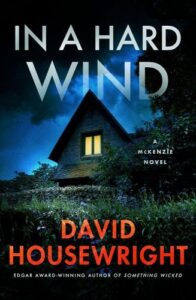To evolve or not to evolve, that is the question.
I had the distinct pleasure and privilege of meeting the late, great Sue Grafton some years ago. During our conversation I mentioned that Kinsey Millhone, the heroine of her best-selling “alphabet series,” hadn’t aged three weeks since A is for Alibi, which debuted in 1982 (I think she was up to U is for Undertow by then).
Sue told me “I just don’t want to deal with the technology.”
I hear you sister.
Back in the day, private investigators could spend a couple of chapters happily exploring the background of a suspect, searching through records down at the county courthouse, interviewing unsavory types on the wrong side of the tracks and, of course, chatting with their close friends in the police department. Now the PI—not to mention the author —can learn nearly anything they want about an individual in an afternoon using a computer. No one ever rips a page out of a telephone book, anymore, or ducks into a drug store to make a quick call.
On the other hand, I can’t imagine spending years following or writing about characters that don’t change, that don’t evolve. How boring. I like characters that are three-dimensional enough to grow or sometimes not grow.
On the other hand, that’s the author talking, not the reader. A major reason they read the books and follow the characters, sometimes religiously, is because they like them just the way they are; they enjoy the situations they become involved in.
Kinsey didn’t change even her hairstyle once over 25 books and I didn’t notice Sue’s sales dropping off. John D. MacDonald’s hero Travis McGee, who went through women the way some people go through tissues, lasted for 21 books in a series that didn’t end until the author passed away. Unlike Sue, MacDonald did mark the passage of time, often commenting on society as he found it. In the final novel, A Lonely Silver Rain, we meet McGee’s grown daughter from one of those aforementioned girlfriends. Yet, neither he nor his pal Meyer changed one iota in all those years.
On the other hand (yes, I know), Reed Farrell Coleman ended his superb series featuring Moe Prager after just nine books, moving Moe forward with every entry until there was simply nothing more to write.
So, what’s an author to do?
My first novel starring Holland Taylor was meant to be a one-off. It became a series after Penance won the Edgar Award and the publisher offered us a three-book deal (the ruthless bastards). Rushmore McKenzie on the other hand (okay, I’ll stop), was meant to be a series. I just didn’t plan on it lasting over twenty years (the first book, A Hard Ticket Home, was published in the spring of 2004, the 20th, In A Hard Wind, will be published June 27, 2023 by St. Martin’s Press).
I aged McKenzie fairly quickly at first – I have a chart pinned to the bulletin board in my office to help me keep track. I slowed the process down, though, when I realized that the character wasn’t going away anytime soon. Yet, while he’s aging at a slower rate than the rest of us – about nine months for every two years in real time – he is changing; he is evolving or devolving depending on your point of view. The question is: How much should I let him?
William Kent Krueger killed off the wife of Cork O’Connor in his series and the pushback was intense, yet the series went on. You could argue that it actually became stronger. Coleman killed off Pam, Moe’s girlfriend, in the eighth book and also experience heavy criticism from his fans. His series ended after just one more book (although I believe that’s what Reed planned all along).
I was going to kill Nina Truhler, McKenzie’s girlfriend, so we could watch him go off the rails. However, Krueger’s and Coleman’s experiences made me think this might not be a good idea after all. Sometime later, my editor told me he would never have allowed that book to be published. “It would have killed the series,” he said.
Probably, he was right. My books are lighter in tone than Kent’s and Reed’s. I actually have jokes. Readers could very easily have said “Okay, that’s it; I’m done.”
Only you see the problem. I believe characters need to evolve, yet readers want each book in a series to feature the same characters they fell in love with in the first book and they won’t be happy if those characters transform into someone who is drastically different. You can argue, as my editor did, that there is a line you simply cannot cross. It’s just a matter of knowing where it is.
At the same time, while your characters might not change, the world surely does. I don’t just mean technologically. Minnesota, especially the Twin Cities, where my stories usually take place, is a different Minnesota today than it was twenty years ago. Hell, it’s not the same as it was just three years ago, yet readers don’t necessarily care to hear that.
I learned this the hard way with the publishing of Something Wicked. In that book I mention both COVID and the murder of George Floyd. Take a glance at the one-star reviews that novel generated on Amazon or Goodreads and you’ll discover some readers didn’t like that one little bit. It didn’t matter both events were pertinent to the story; that they helped explain the motivation of a couple of important characters. How dare I interject my politics into a McKenzie novel?
Truthfully, I didn’t. I merely wrote that one thing happened and a character did this and another thing happened so a character did that. It didn’t matter. To some readers the mere mention of those events created an environment they simply didn’t expect to see in a McKenzie novel so they vowed to stop reading them.
Wow.
I always believed that if you were from where they were from and you were taught what they were taught, you would believe what they believe. That’s why setting is so important. If you can truly capture the environment where the story takes place, then the reader will have a better understanding of who the characters are that live there and why they behave the way that they do.
You need to be authentic; you need to describe the world where the story takes place accurately. Right? You tell readers this is how things are; this is why things work the way they do. Apparently, though, there are lines you cannot cross in this regard as well.
So, what’s a writer to do?
I’ve already mentioned four authors who have taken different paths. As for me, I advise that you write characters that evolve only gradually over time.
Also, you should consider writing each book as if the other books don’t exist. I make references to characters and events from previous novels only when they are pertinent to the story I’m telling now. In A Hard Wind features only three characters from the series including McKenzie and Nina. In What Doesn’t Kill Us I brought back fifteen!
I believe this will not only appease your fans, it will also help with sales. Often readers have asked “Which book should I start with?” I tell them to start with whichever book is closest at hand. What’s the alternative? Read the previous nineteen in order – they’re all available in trade paper – before jumping in with the twentieth coming out in June?
What it eventually comes down to is giving the reader what they expect while accommodating your needs as a writer; it’s knowing where the lines are drawn.
How do you do that? Let me know what you decide. I need to get to work on number twenty-one.
***


















